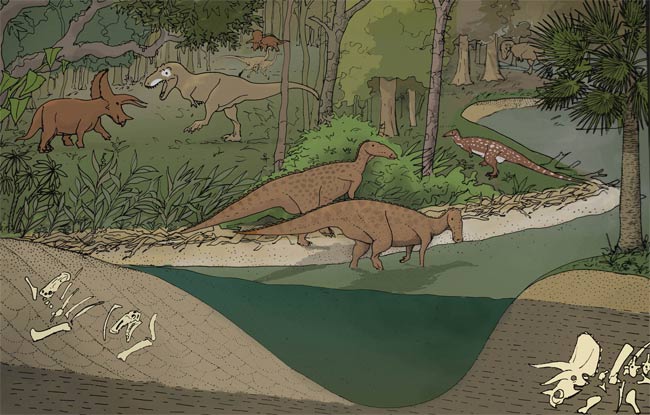Where Dinosaurs Died Reveals How They Lived

By looking at where dinosaurs died, scientists have uncovered new insights into how they lived.
It seems that Triceratops lived away from rivers, duck-billed dinosaurs dwelled near rivers, and T. rex was equally common everywhere, probably because the beast went wherever there was meat, researchers find.
The age of dinosaurs was a time of giants, and near the end of this era, these behemoths often lived surprisingly close to one another in the coastal lowlands of North America. As such, vertebrate paleontologists Tyler Lyson and Nicholas Longrich at Yale University reasoned the titans might have divided the landscape among themselves, so as to not constantly butt heads.
After the scientists analyzed 343 dinosaur skeletons of this time and place from 43 museum collections, they found links between the kind of dinosaurs they investigated and the kind of rock they were initially discovered in.
"We can use the rock enclosing these fossils as clues to what they were up to," Lyson told LiveScience. "We're using what paleontologists usually throw away when excavating the fossils as clues to where they're spending most of their time."
The 180 Triceratops skeletons they examined were mostly seen in mudstone laid down on floodplains by a nearly 2-to-1 ratio when compared with sandstone, while the 80 duck-billed dinosaurs known as hadrosaurs were most commonly found in sandstone laid down in rivers by a roughly 15-to-1 ratio when compared with mudstone. Nineteen skeletons of the bipedal herbivore known as Thescelosaurus were also discovered predominantly in sandstone by an 8-to-1 ratio compared with mudstone. Like duckbills, Thescelosaurus likely lived mainly close to rivers.
"It makes sense these different herbivores are spatially separated — if you look at modern times, white-tailed deer hang out by rivers while mule deer are by the plains," Lyson said.
Get the world’s most fascinating discoveries delivered straight to your inbox.
On the other hand, the 45 T. rex skeletons the researchers investigated showed no preference for either environment.
"That makes sense — as the sole large carnivore in this time and place, it would go to wherever meat was," Lyson said.
Future research can look at other groups of dinosaurs. "We could also look at different subgroups of dinosaurs — did all hadrosaurs spend time by the rivers, or were others more in floodplains?" Lyson noted.
Lyson and his colleagues detailed their findings online Oct. 13 in the Proceedings of the Royal Society B.
- 25 Amazing Ancient Beasts
- Images: Dinosaur Drawings
- The World's Deadliest Animals



